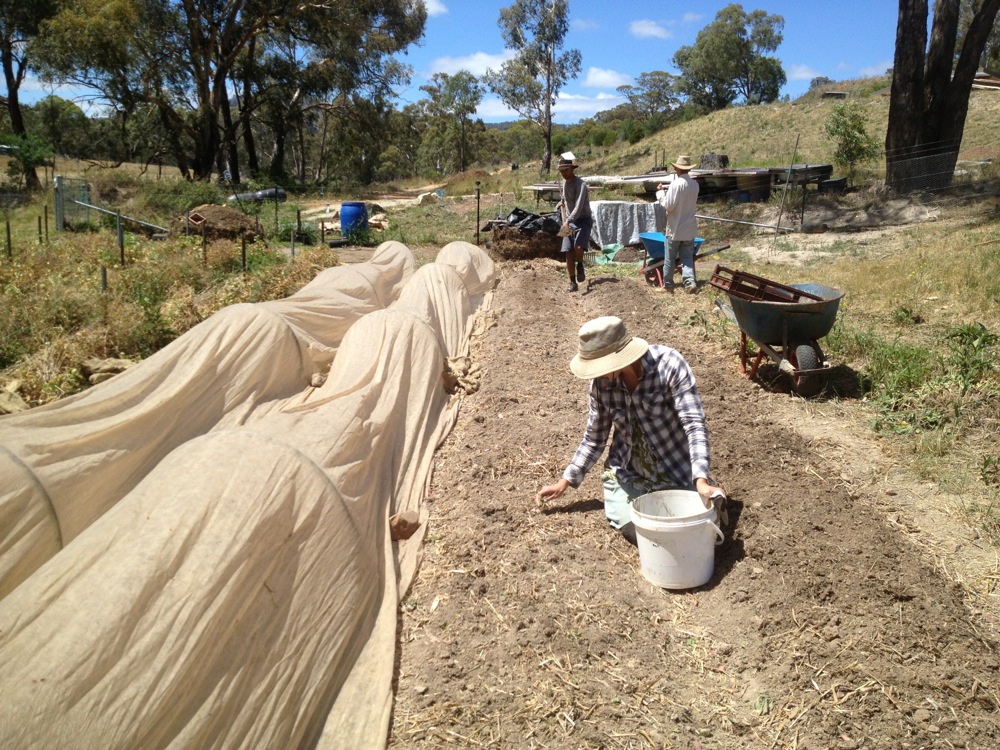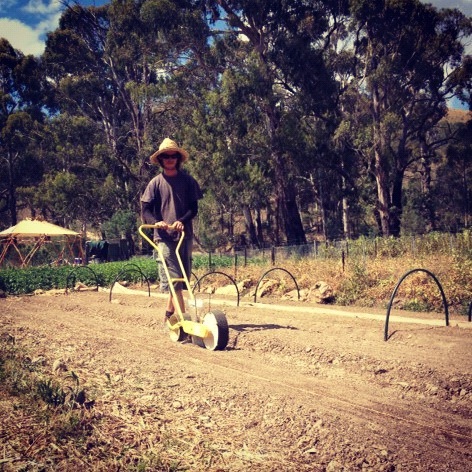
Last year it was so easy, the carrots seemed to grow themselves! This year, however… not so much.
Carrots are one of those crops that, in dry summers like this one, need a lot of love and care from before they’re even planted, all the way through to harvest. Under Michael’s tender care the carrots are flourishing, but there were many tricks to getting them this far! A good seed bed was the first step. Carrots need super-friable soil to flourish, and a finely cultivated bed to do it in. On our site, with our soil, in this super dry spring, creating these parameters was a challenge in themselves.
A good seed bed was the first step. Carrots need super-friable soil to flourish, and a finely cultivated bed to do it in. On our site, with our soil, in this super dry spring, creating these parameters was a challenge in themselves.
Michael and the intern/woofer crew raked and chopped and broadforked and then raked again until the beds were as ready as they could be, with a fine grade of soil on top for the seed bed.

The reason for this extra care and attention to the seed bed was partly so that we could use our new seeder to sow said carrots. This seeder drops a single seed one after the other at a precise spacing all along the row. It is a brilliant thing.
If you don’t have a seeder, making a small shallow furrow down the length of your bed and mix the carrot seed with sand before trickling it into the furrow. Your germination will be more patchy, but still pretty good. This is what we did last year and we got a fair crop with this method.
The other reason and benefits of all this fine bed prep and precise seeding is at the core of organic market gardening with crops like carrots:
You will be weeding this bed. Many times between planting and harvest. There are no chemicals here, no targeted herbicides that wipe out everything but your chosen crop, reduce the weeding load and helping create a culture of carrots at 50 cents a kilo.
If the carrots are lined up, you can weed easily between them. If the soil is friable, it not only benefits the carrots germination but also makes weed seedlings much easier to dislodge in their early growth without also dislodging your precious carrots.
Growing carrots is a marathon – they won’t be ready for about 4 months. And we need to water them from above with sprinklers, because drip irrigation will not do the job with this crop (the drips are too far apart).
The upside of overhead watering with sprinklers is that everything in the bed gets watered. And that is also the downside of overhead watering. Everything gets watered, including all the other seeds in the incredible living seed bank that is our soil. And hence they grow too.

Come on you beauties
To ensure good germination, Michael covered the seeded beds of carrots with hessian until they germinated and were ‘up’. Carrots need heat and water to germinate, but not light. So hessian layed on top of the rows stopped the friable soil from drying out during this tricky phase.
The hessian trick works at a domestic scale too and is a good one to try. Make sure you get un-treated hessian (most bags are treated with anti-rodent chemicals) if you can – our friends Craig and Susan over the hill at Morrigan Farm sell natural hessian by mail order if anyone’s in need.

2 rows of germinating hessian-clad carrots to left, earlier carrots that are up and attem to the right
Michael was pleased with the germination rate we had from our carrots this year despite all the difficulties of the dryest Spring/Summer on record etc. And now they’re off at a trot, and all being well we should be harvesting baby rainbow carrots by March-ish. We hope.
Experiences like this do beg the question of suitability of crops to climate, and that is an ongoing conversation at Milkwood Farm. A lot of the time growers (Permaculturalists included) like to push the boundaries of what will bear in the growing conditions provided.
In an intensive vegetable garden, these boundaries are sometimes pushed much further, because we all want to hope that we can grow our favorite foods, even if it’s not quite the growing conditions for them. And all the gardeners in the magazines say if I follow these 5 simple steps i’ll have amazing (insert here: tomatoes/spinach/potatoes/watermelons/etc) this year…
But because we’re talking annual and not perennial crops here, the trade off is the workload and energy inputs to get a harvest from each of those boundary-pushing crops… and in an organic system, that is a lot of human inputs and energy.
Some growers get around this the logical way, by only growing 3 or 4 things that grow really well on their site – which is a fair call. But in a diversified system that is trying to grow as much of the food needed for a varied diet as possible (say in a CSA for example, or in a system like ours which is aiming to provide a catering kitchen with as many different veggies as possible), where does that leave us all?
Planning for resilience, that’s where! Reviewing planting and harvest data each year, and edging towards a resilient diversity based on our site.
Take it slow, keep going, spread knowledge, help others begin based on what you’ve learned. Ask questions, read, read, read, review the garden diary from this time last year, plan ahead and most of all observe and interact with the garden itself. And keep growing.

Rainbow carrots from last year’s April harvest… just the beginning…
We run Organic Market Garden training at beginner and masterclass levels at Milkwood farm and Allsun Farm, helping to grow more Australian growers. We also run Serious Backyard Veggies courses for growers wanting to grow seriously excellent food int heir backyards.
Big thanks to Michael and all the wwoofers and interns who have helped get our carrots in and growing. Hooray for you. Also big thanks to Allsun Farm for supplying us with our fabulous Jang seeder which we love a lot.
>> More articles and resources about market gardening here…














Hi Kirsten, what seed wheel did you use for the carrots? Did that give you the desired spacing or was thinning still required? I’ve been looking at seed tapes and pelletised seeds although this seems too reliant on external factors for my liking although we could make our own tape. I find thinning too labour intensive for the price return on carrots. Happy to hear anyones thoughts
Yep the seed wheel wasn’t quite the right one I don’t think so thinning will be required, but better than the alternatives we reckon! Same as you we don’t want to rely on the that we have to buy in every year ( seed tape etc)… Need to get our act together and get exactly the right seed cog for carrots next round!
Me too, we have to grow them, love eating them and customers pay a little extra because they are good. But have to get past the labour intensive thinning. I made a little tool based on this- http://www.johnnyseeds.com/p-8319-lucko-wire-weeder.aspx and run through as quick as I can just after emergence which helps. But 4 or 5 lines at 150m takes a long time even with the wire. Might send a cog and sample seed up to Allsun and see what comes of it. Good health. See you soon.
Hi Fraser,
we used an MJ-24 seed wheel to sow these carrots, which isnt actually ideal as it is for coated seed. We will still need to thin as the spacing was thrown out from 1-2″ apart and patchy due to the seed wheel delivering more than one seed per divit… obviously not ideal. I believe the Y series seed wheels are the go for carrot seed, we will be ordering one from allsun.
Carrots look great. Because of my beyond rocky soil, I’ve taken to growing my carrots in a poly tunnel in recycled polystyrene boxes. Works a treat!!! First time I was successful growing carrots!
Hi Kirsten, thanks again for yet another great article. We are trying to grow carrots in the hot and dry which is most of the year nowdays in Western Australia, and my method by now ( 30 years gardening) is: chook the area to weed and fertilise, move the chooks out, hose the level bed till wet right down, then mulch the whole wetted bed with grass clippings from the tip. Make small furrows in that, trickle in the seed with sand as you say, cover with half a cm compost, hose again, cover that with thin layer seed free… Read more »
Wow thanks for that advice! So… You don’t have probs with too many grass seeds coming in with those grass clippings?
Hi, Kirsten. I found your blog just in time. I will be working on a C.S.A. starting in March. The farm is organic and everything is started from seed. Reading you blog is helping me understand how things are done. I just hope someone watches me so I don’t mess things up!!!
A very unconventional method contrary to all advice you will read, but something that is working successfully for me – germinating carrots (4-6 seeds) in a soil block (1.5″) then transplanting while still small. This also allows them to be planted out and grown under drippers – added bonus of set spacing for weeding. With the wide spacings I have found the carrots still have plenty of space to grow out despite “crowding” – similar to Elliot Coleman’s concept with onions. A little labour intensive, but better than missing out on tasty home grown carrots. We are also experiencing a… Read more »
Have you seen the garden film on the internet at
http://www.backtoedenfilm.com ? If not you might be interested.
Reblogged this on X_trous Notes.